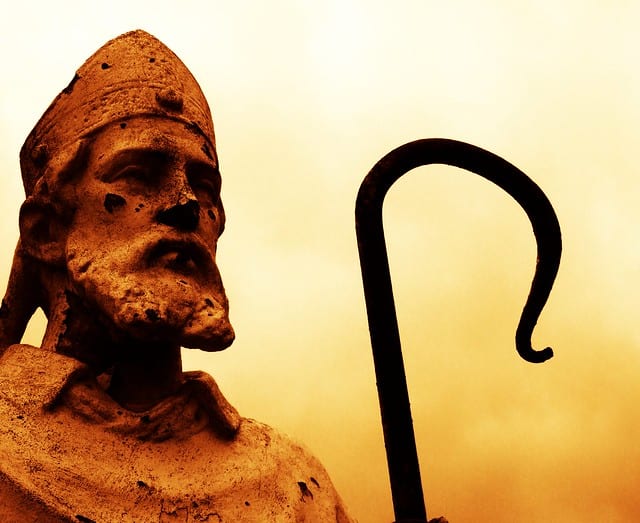
Stillness on Saint Patrick’s Day
This year Saint Patrick’s Day has greater stillness than it usually does.
Is there more to Saint Patrick’s Day than revelry and green beer or people who have Irish heritage? What is it all about?
Saint Patrick’s Day begins with the story of a real person, the Patrick who became a patron saint.
We do not have a lot of independent historical information about Patrick. Most of what we think we know about him is from what he wrote himself.
Patrick was born in the fourth century in Roman Britain. His father and grandfather were both active in the Christian church. When Patrick was sixteen years old he was kidnapped by Irish traders and taken as a slave to Ireland. He spent six years in Ireland working as a shepherd, during which time Patrick “found God.” Patrick believed God told him to flee to the Irish coast where a ship would be waiting to take him home to Britain. After traveling home, Patrick subsequently became a priest in the church.
According to tradition, Patrick returned to Ireland to preach Christianity to the Irish.
Saint Patrick’s Day is a cultural and religious celebration on the date of Patrick’s death.
We do not celebrate Saint Patrick’s Day to recognize the work and life of one person. Patrick was not the only, or even the first, person to take Christianity to Ireland. His work was, in many ways, planting seeds and getting things started. Patrick worked with other people who continued working after his death.
Spiritual life in Ireland shaped religious communities which combined organization and organic strength. On Saint Patrick’s Day we celebrate the unique path of Celtic spirituality.
What Are We Celebrating on Saint Patrick’s Day?
We celebrate Irish culture and Celtic spirituality on Saint Patrick’s Day. Many of us are aware of aspects of Irish history, Irish music and literature, and the beauty of Ireland. We may have less of a clear understanding of what makes Celtic spirituality unique.
There are many resources through which we can explore Celtic spirituality. The story of the Celts and Celtic spirituality is filled with beautiful prayers and music. Colorful, distinctive people with memorable ideas and personalities populate the story.
Today we think of Ireland as a Roman Catholic country. Christianity was most likely introduced into Ireland by Roman Catholics. Ireland’s remoteness from Rome, though, allowed Celtic spirituality to continue developing in unique ways. The mixture of imported Christianity and Irish traditions and culture shaped Celtic spirituality.
We Celebrate the Spiritual Life of Nature
One way Celtic spirituality shaped Christianity in Ireland is toward the goodness of nature.
Much of what many of us think of as Western Christianity emphasizes how far we fall from God. There was, and is, a focus on the power of evil in the world.
The church in Ireland developed a different perspective.
Celtic spirituality recognizes the realities of the world. It is more centered on the goodness of creation than on what is broken in the world. God is alive in the world and revealed in the natural world.
Celtic Christians lived close to nature and take time to reflect on its variety and beauty. They draw deep spiritual lessons from the natural world all around them. Celtic spirituality is able to integrate Biblical teaching with the Druidic heritage of Ireland.
Listening to sacred stillness is a significant aspect of Celtic spiritual life.
We Celebrate The Spiritual Life of Imagination
Celtic spiritual life values our imagination.
A reflective, contemplative understanding of the natural world encourages imagination. When we look at the world around us we see God in imaginative ways. Celtic spirituality recognizes the power of spiritual life all around us, and within us.
We rely on our senses to recognize and appreciate spiritual life. What our senses tell us is integrated with imagination.
Celtic imagination produces a wide variety of art and artifacts. Imagination is evident in poetry and other writing, weaving and metalwork, carving and architecture.
An imaginative approach to the world feeds the continued growth of Celtic spirituality.
As we follow the example of Celtic spirituality the world opens to our imagination. We begin to see spiritual life shaping and undergirding the world around us.
We are not physical beings who happen to have spiritual experiences. Our lives are as spiritual beings who are interpreting physical experiences.
Celtic spiritual life is more reflective than conceptual or theoretical.
We Celebrate the Spiritual Life of Real People
Celtic spiritual life is not primarily a story of educated, certified men. It is more a story of Celtic communities, men and women, reflecting on their experiences.
While some key figures in Celtic spiritual life have been scholars, many have not. Celtic Christianity has a much stronger sense of growing organically from a community. The structure of the church is less hierarchical and less centralized.
Individual people experience the goodness of the natural world. They rely on their imaginations to interpret it. There is less dependence on analytical thinking and more on reflective imagining. Each member of the community is qualified to understand the world for themselves. Spiritual life is accessible to all of us.
We Celebrate Celtic Spiritual Life
Today is not merely a day for green beer and Irish revelry. We celebrate not only one person but the accomplishments of what Patrick may have started.
Patrick is a symbol of Celtic spiritual life, integrating Christianity and traditional spirituality.
We celebrate spiritual life which values the goodness and spiritual life of nature. Our celebration is about the spiritual life of imagination. We celebrate the spiritual life of real people.
The lessons and values of Celtic spiritual life continue to grow and develop today.
There are times when we may lose sight of Celtic spirituality even as we celebrate it. We take time today to remember and reflect.
What are we imagining and reflecting on this Saint Patrick’s Day?
How will Saint Patrick’s Day shape how we listen to sacred stillness this week?
[Image by jaqian]
Greg Richardson is a spiritual life mentor and coach in Southern California. He has served as an assistant district attorney, an associate university professor, and is a lay Oblate with New Camaldoli Hermitage near Big Sur, California. Greg’s website is StrategicMonk.com and his email address is [email protected].












